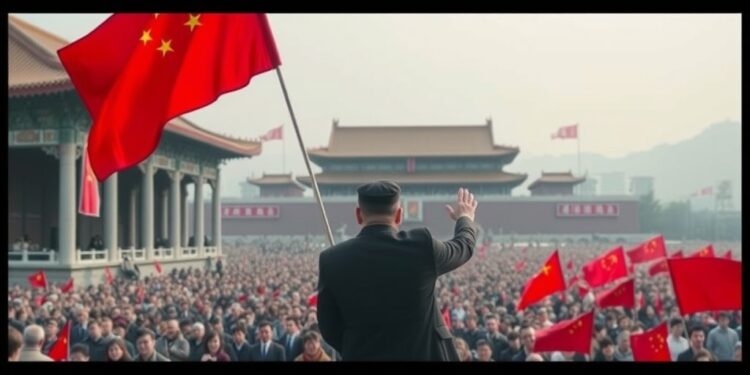In a groundbreaking study co-led by Hannah Waight, an assistant professor of sociology at the University of Oregon, researchers have uncovered a disturbing trend in China’s media landscape: state-sponsored propaganda disguised as news is increasingly infiltrating newspapers across the country. This study reveals that the Chinese government’s influence over media has escalated dramatically, leading to a systematic control not only of ideological narratives but also of critical information surrounding natural disasters and public health crises.
The findings are particularly alarming given the context of rising political authoritarianism under President Xi Jinping. Waight indicates that on sensitive days, up to 30 percent of major newspaper content may originate from state propaganda. This overwhelming presence of government-scripted narratives not only stifles independent journalism but also delays critical information dissemination during emergencies such as earthquakes and public health epidemics like COVID-19. This pattern compromises the integrity of news reporting and ultimately the informed state of the public.
The overarching research highlights that state-directed propaganda permeates the media in China nearly every day, with instances of scripted narratives appearing around 90 percent of the time. The frequency of these articles is alarming, with at least one front-page piece planted by the government in party-affiliated newspapers on average. Over the past decade, their research indicates a fourfold increase in such occurrences, revealing a drastic shift in the media landscape correspondingly aligned with Xi Jinping’s consolidation of power.
To investigate the magnitude and depth of this issue further, the researchers employed an innovative measurement method to analyze millions of newspaper articles spanning a decade from 2012 to 2022. This methodology proved crucial in identifying when and how newspapers adhered to narratives dictated by the government, particularly highlighting instances where editorial freedom was coerced or circumvented.
The method of using leaked documents from China Digital Times, a U.S.-based media organization, enabled the research team to validate their findings efficiently. These documents contained direct directives from the government dictating what should be published by newspapers. A meticulous comparison confirmed that their approach accurately identified instances of propaganda, solidifying the credibility of the research findings.
Extending beyond conventional definitions of propaganda, this study encompasses a broader array of topics manipulated by the state. The researchers dug deeper into two critical areas – earthquakes and the COVID-19 pandemic – to illustrate the extensive reach of government propaganda beyond traditional ideological content. The choice of earthquakes as a case study is particularly noteworthy, given the sensitive nature of reporting on significant disasters in the aftermath of the devastating 2008 Sichuan earthquake, which led to heavy scrutiny of the government’s failings in infrastructure and disaster response.
Subsequent to the 2008 catastrophe, the sensitive nature of earthquake reporting transformed, characterized by government control over media narratives. By juxtaposing earthquake data from reliable sources, like the United States Geological Survey, with media coverage, the researchers highlighted a consistent decline in reporting. When coverage did occur, it increasingly mirrored government scripts, diluting independent journalistic efforts.
A parallel trend emerged against the backdrop of the COVID-19 outbreak in Wuhan, which commenced lockdown procedures in January 2020. The suppression of critical reporting was stark, with major outlets opting to ignore growing public concern for more information on the health crisis. This information vacuum, coinciding with surging public interest reflected in digital search trends, illustrates the detrimental effects of government-imposed restrictions on media.
Waight emphasizes that their findings suggest that the use of state-sponsored propaganda is not merely about promoting ideological agendas but is also fundamentally about constraining the discourse surrounding politically sensitive events. This control has serious implications for the public’s access to unfiltered news and information, raising pressing questions about the public’s ability to discern independent journalism from state-sanctioned narratives.
As this study spotlights the rising arm of state propaganda in China, Waight expresses hopes that academia will build upon their research to examine similar phenomena in other authoritarian regimes worldwide. While their work primarily focuses on China, the methodological strategies they developed could prove essential for investigating how different governments employ covert propaganda strategies to infiltrate and manipulate media ecosystems.
The imperative remains that researchers and journalists alike seek further understanding of government propaganda’s nuanced effects on public perception and belief systems. The ability of citizens to critically evaluate the information presented in the media is closely tied to the health of democratic societies. Therefore, further exploration into this subject could unveil critical insights that empower the public to navigate increasingly complex media landscapes.
In essence, the emergence of state-scripted news in China serves as both a symptom and a catalyst of expanding authoritarian control. As the boundaries of free speech tighten, the resilience of independent media faces a formidable challenge. This landscape necessitates ongoing scrutiny to ensure that the principles of transparency and truth remain paramount in informing the public.
Subject of Research: The growth of state-sponsored propaganda in Chinese media
Article Title: The decade-long growth of government-authored news media in China under Xi Jinping
News Publication Date: 11-Mar-2025
Web References: Proceedings of the National Academy of Sciences
References: Not provided
Image Credits: Not provided
Keywords: Propaganda, Chinese media, state influence, authoritarianism, public health reporting, earthquakes, Xi Jinping.




